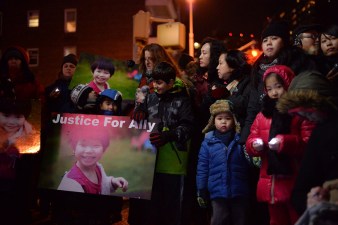The New York State DMV Primer: Why Two Hearings for Killer Drivers?
Editor’s note: This is the first installment in a series of Streetsblog columns and stories on the workings of the New York State Department of Motor Vehicles, its role in deterring or facilitating traffic violence, and agency reforms that could make streets and roads safer.
Many questions arose when news broke that the motorist who struck and killed 3-year-old Allison Liao had been acquitted by the New York State Department of Motor Vehicles of the traffic violations he was charged with — careless driving and failure to yield — but that the same motorist would be appearing at a DMV “safety hearing” in January. Since the DMV threw out all tickets issued to Ahmad Abu-Zayedeh, what is the purpose of this second “safety hearing”?
The reasons are in large part historical. There is an English-American criminal procedure tradition stretching back 500 years for how to handle government attempts to punish an alleged wrongdoer. The accused is given certain procedural rights, because historically these types of hearings were fraught with abuse and overreach by the state. The accused has a right to confront witnesses against him or her, to refuse to give testimony against him or herself, to be presumed innocent and force the government to prove the charges.
Even though a hearing on a traffic infraction — what happens when a person receives a traffic ticket for a moving violation — is not a criminal hearing, it is like one and is rooted in the same legal traditions. It is like a criminal hearing in the sense that the government (police, specifically) is accusing and seeking to punish an individual. For lawyers, this triggers all the historical references to what a criminal trial should look like. Not surprisingly, the DMV regulations governing traffic ticket hearings allow a driver the right to counsel and a right not to testify (and therefore a right not to be forced to look at a videotape, as Abu-Zayedeh has refused to do). The driver has a right to force the state to a higher standard of proof — not quite the “beyond a reasonable doubt” standard of a criminal hearing, but the “clear and convincing” standard, which is also quite high.
Though it is just a traffic ticket hearing, most lawyers and legal policy makers (not to mention most drivers) would agree that these advantages for the “accused” are crucial to the fairness of the process. In essence, the procedures for conducting hearings on traffic infractions are stacked in favor of the accused, based primarily upon tradition, rather than upon the reasons the traditions evolved in the first place (i.e., governments using criminal prosecutions to suppress political dissent).
In contrast, an administrative hearing to review a government license is a product of the 20th century administrative state. It has only been around for about 50 years. There is very little baggage from the pre-modern era regarding the conduct of these hearings. There is also a frank recognition that the stakes are much lower than in the criminal setting — there are no penalties except for the possible suspension or revocation of driving privileges. While the proceeding still must be fair, few would suggest in the licensure review context that the deck should be heavily stacked in favor of the license holder.
Accordingly, the procedures for a DMV safety hearing are very different from those in the traffic ticket hearing. The license holder must answer the questions posed — there is no right to remain silent. Presumably this means the driver can be shown a videotape and required to answer questions about it, if that is what the judge decides to do.
There are also no strict limits on what evidence is admissible, and the judge has to decide whether the license is to be suspended based on a “preponderance of the evidence.” A preponderance standard means it is at least 51 percent likely — in other words, perhaps only marginally likely — that an assertion is true. A “clear and convincing” standard requires that it be “highly likely” to be true. At the far end of the spectrum, proof “beyond a reasonable doubt” means that no reasonable person would disagree that the matter to be proven is true.
There would be substantial benefits in combining the two types of hearings. It wastes the system’s resources, as well as the time of witnesses and victims’ families, to hold two hearings. A combined hearing should involve a more careful and thoughtful look at the evidence, and avoid the risks of inconsistent outcomes in the two hearings.
However, combining the two hearings would require that the higher standard of proof, and other procedures intended to stack the deck in favor of the driver, would have to apply to the entire hearing. In practice, that would make it even harder to suspend the licenses of reckless drivers.
The better route, at least for now, is to work within the two hearing structure, and do everything we can to make each type of hearing as fair and transparent as possible, in order to maximize the likelihood of meaningful consequences for the driver.
If the driver is convicted of traffic infractions at a hearing, it should almost go without saying he or she will have his or her license suspended if the violation caused death or serious injury to another person. (One of the five DMV reforms recommended by Families for Safe Streets is that there should be an automatic suspension without the need for a safety hearing if a driver gets six license points, which can be accumulated for as little as two serious traffic violations.) But if the driver “beats” the tickets at the ticket hearing, there is a second chance — at the safety hearing — to prove that the driver is unsafe and should have a license suspension or revocation. The same evidence that might be insufficient to win a conviction on the tickets may well be enough to take the license away in the second hearing.


